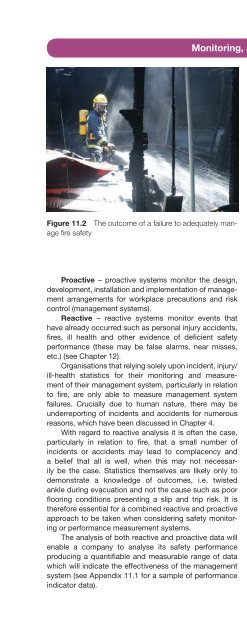Introduction to Fire Safety Management
Introduction to Fire Safety Management
Introduction to Fire Safety Management
You also want an ePaper? Increase the reach of your titles
YUMPU automatically turns print PDFs into web optimized ePapers that Google loves.
Figure 11.2 The outcome of a failure <strong>to</strong> adequately manage<br />
fi re safety<br />
Proactive – proactive systems moni<strong>to</strong>r the design,<br />
development, installation and implementation of management<br />
arrangements for workplace precautions and risk<br />
control (management systems).<br />
Reactive – reactive systems moni<strong>to</strong>r events that<br />
have already occurred such as personal injury accidents,<br />
fi res, ill health and other evidence of defi cient safety<br />
performance (these may be false alarms, near misses,<br />
etc.) (see Chapter 12).<br />
Organisations that relying solely upon incident, injury/<br />
ill-health statistics for their moni<strong>to</strong>ring and measurement<br />
of their management system, particularly in relation<br />
<strong>to</strong> fi re, are only able <strong>to</strong> measure management system<br />
failures. Crucially due <strong>to</strong> human nature, there may be<br />
underreporting of incidents and accidents for numerous<br />
reasons, which have been discussed in Chapter 4.<br />
With regard <strong>to</strong> reactive analysis it is often the case,<br />
particularly in relation <strong>to</strong> fi re, that a small number of<br />
incidents or accidents may lead <strong>to</strong> complacency and<br />
a belief that all is well, when this may not necessarily<br />
be the case. Statistics themselves are likely only <strong>to</strong><br />
demonstrate a knowledge of outcomes, i.e. twisted<br />
ankle during evacuation and not the cause such as poor<br />
fl ooring conditions presenting a slip and trip risk. It is<br />
therefore essential for a combined reactive and proactive<br />
approach <strong>to</strong> be taken when considering safety moni<strong>to</strong>ring<br />
or performance measurement systems.<br />
The analysis of both reactive and proactive data will<br />
enable a company <strong>to</strong> analyse its safety performance<br />
producing a quantifi able and measurable range of data<br />
which will indicate the effectiveness of the management<br />
system (see Appendix 11.1 for a sample of performance<br />
indica<strong>to</strong>r data).<br />
Moni<strong>to</strong>ring, auditing and reviewing fi re safety systems<br />
11.1 Benefi ts of moni<strong>to</strong>ring and<br />
measuring<br />
A key aspect of safety management is <strong>to</strong> strive for continuous<br />
improvement of performance. Therefore it is vital<br />
that organisations are able <strong>to</strong> know how well their systems<br />
are performing. Data gathered by moni<strong>to</strong>ring systems<br />
will enable an organisation <strong>to</strong> understand:<br />
➤ Its current position in relation <strong>to</strong> its safety management<br />
➤ Its progress against its standards<br />
➤ Its priorities for action<br />
➤ The effectiveness of its resource allocation and<br />
management<br />
➤ The areas where it may be exposed <strong>to</strong> excessive<br />
risk<br />
➤ Where and how its management systems should be<br />
reviewed.<br />
Establishing an effective moni<strong>to</strong>ring and measuring system<br />
helps <strong>to</strong> demonstrate management’s commitment<br />
<strong>to</strong> safety objectives in general and will also assist in the<br />
development of a positive safety culture, particularly<br />
rewarding any positive work undertaken in controlling<br />
levels of risk.<br />
In addition, information gathered through the<br />
performance measurement enables managers <strong>to</strong> understand<br />
how well they are managing in comparison <strong>to</strong> their<br />
previous experience and the performance of others in<br />
similar industry sec<strong>to</strong>rs. With safety performance data<br />
that can be compared across an industry, the process of<br />
benchmarking safety performance can give useful insights<br />
<strong>to</strong> managers. By using comparative data, benchmarking<br />
can be conducted both internally and externally. Table<br />
11.1 gives some examples.<br />
When compiling the performance statistics an organisation<br />
will need <strong>to</strong> take in<strong>to</strong> account the mechanisms<br />
by which it will gather the information. These should be<br />
refl ected in the safety policy particularly in relation <strong>to</strong><br />
reporting and investigation of safety events, incidents,<br />
accidents, etc. and its proactive moni<strong>to</strong>ring, inspections,<br />
<strong>to</strong>urs and audits.<br />
11.2 Active safety moni<strong>to</strong>ring<br />
procedures<br />
11.2.1 Proactive moni<strong>to</strong>ring<br />
The purpose of proactive moni<strong>to</strong>ring is <strong>to</strong> provide feedback<br />
on an organisation’s safety performance before a<br />
personal injury accident, fi re, illness, etc. occurs.<br />
269

















